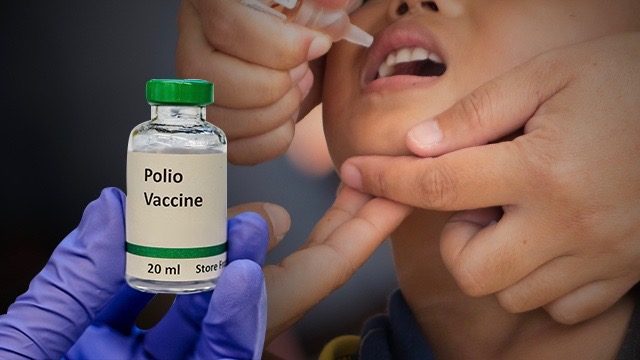SUMMARY
This is AI generated summarization, which may have errors. For context, always refer to the full article.

MANILA, Philippines – The Department of Health (DOH) on Thursday, September 19, declared a polio epidemic after it recorded a case of the disease in Lanao del Sur. This is the country’s first confirmed case after 19 years of being polio-free.
The DOH said it found the disease in a 3-year-old girl who is “now apparently well but with residual paralysis.” The case was confirmed on Saturday, September 14. (READ: EXPLAINER: What is polio?)
“The result of [the girl’s stool exam showed vaccine-derive poliovirus (VDPV) type 2, and the child was unvaccinated against polio,” DOH Epidemiology Bureau Director Ferchito Avelino said.
The DOH said it is waiting for another case to be confirmed, adding that they would make an announcement once it is confirmed.
Health Secretary Francisco Duque III told media on Thursday the DOH declared an “epidemic” or “outbreak” after they found one positive case of the disease in Lanao del Sur and after environmental samples from Manila and Davao tested positive for poliovirus, as these are “considered an epidemic in a polio-free country.”
The country was declared polio-free since October 2000, with the last case of poliovirus reported in 1993.
The DOH said it found type 1 poliovirus in Manila and type 2 in Davao. There is another type of poliovirus, type 3. Their main difference is the makeup of the outer, protective coating called the capsid.
According to Rotary International, an organization which has been conducting anti-polio initiatives for 30 years, type 1 poliovirus is the known cause of the few cases of the disease existing in the world today. Type 2 poliovirus, meanwhile, was declared eradicated in September 2015, with the last virus detected in India in 1999.
The DOH sees low vaccination coverage, poor early surveillance of polio symptoms, and substandard sanitation practices as culprits in this reemergence.
The DOH had earlier said that the Philippines was at “high risk” of poliovirus transmission after Manila’s sewage showed two samples that tested positive for poliovirus.
Polio or poliomyelitis is a highly contagious disease caused by poliovirus invading the nervous system. Symptoms include fever, fatigue, headache, vomiting, stiff neck and sudden onset of floppy arms or legs. In severe cases, it can lead to permanent paralysis or even death. Children under 5 years of age are most vulnerable to the disease.
The Thursday announcement comes amid an ongoing measles outbreak and dengue epidemic in the country.
Vaccination, cleanliness are key
The health department found that polio vaccination for children below 5 years old dropped to less than 95% in 2018. Health Secretary Duque said the average national polio vaccination stands at about 66-68%.
“We need to bring this up to 95% level to ensure herd immunity,” he said. “We strongly urge parents, health wrokers, and local governments to fully participate in the synchronized polio vaccination,” he added.
The DOH on August 19 launched its “Sabayang Patak kontra Polio” campaign in the City of Manila, where the poliovirus sample was found. On Friday, September 20, Rotary Philippines will launch an NCR-wide polio vaccination campaign, beginning in Quezon City.
The health department will expand the vaccination campaign to other Metro Manila cities on October 1, with a target of 1,276,658 children below 5 years old for its second round. The vaccination campaign will also kick off in Davao and Lanao del Sur in October.
The third round will be conducted in Central Luzon (Region III) and Calabarzon (Region IV-A) from November 19-30, targetting 4,090,228 children under 5 years of age.
The DOH had earlier said that the main challenge confronting the agency in its conduct of door-to-door vaccination was the fact that children and guardians are usually not around when they make the rounds.
In a survey covering 370 households in the City of Manila, the DOH found that 153 kids were not vaccinated because they were not in their homes during the campaign. Meanwhile, 8 kids had their guardians around but refused vaccination due to vaccine hesitancy. (READ: A year after Dengvaxia: Immunization drops, measles outbreaks soar)
The DOH assured the public that aside from door-to-door initiatives, it would deploy resources in health centers nationwide.
The World Health Organization (WHO) is working closely with the DOH in its anti-polio response. “Even if children had already been vaccinated, they need these additional doses to be fully protected,” said WHO Country Representative Rabindra Abeyasinghe.
The vaccination schedule for preventing polio, as recommended by the (WHO), involves 3 doses of oral polio vaccine (OPV) and one dose of inactivated polio vaccine (IPV). It is the OPV that contains live, weakened virus that may cause VDPV.
The health department also urges local governments to intensify their Zero Open Defecation program and calls for proper sanitation practices, like regularly washing one’s hands. – Rappler.com
Add a comment
How does this make you feel?
There are no comments yet. Add your comment to start the conversation.